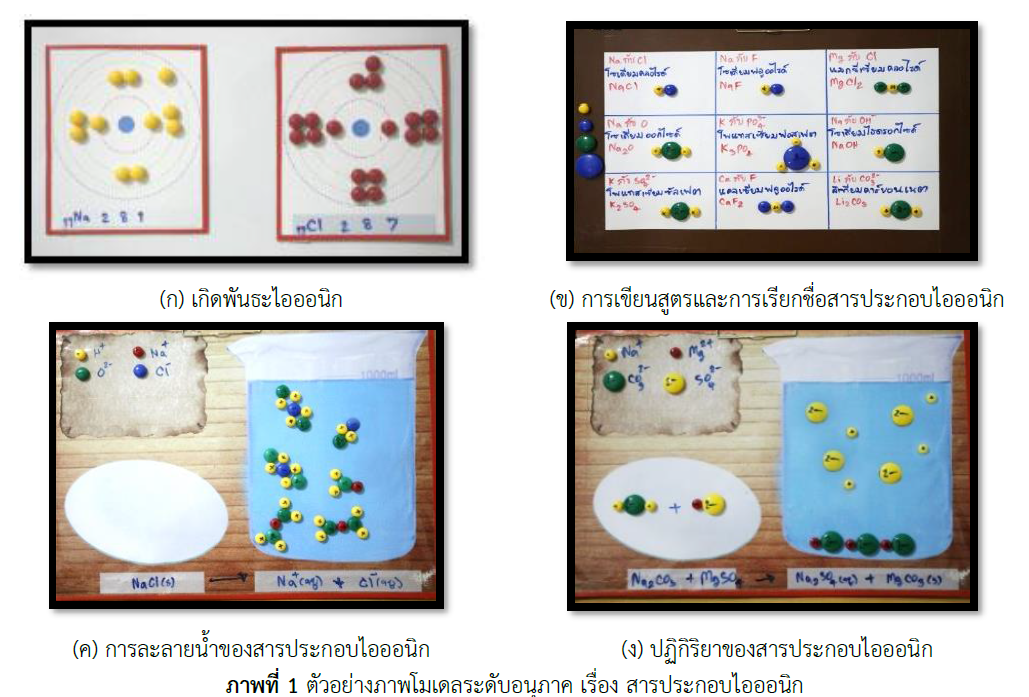การพัฒนาความเข้าใจมโนมติของนักเรียนชั้นมัธยมศึกษาปีที่ 4 เรื่อง สารประกอบไอออนิก ด้วยการเรียนรู้แบบสืบเสาะร่วมกับโมเดลระดับอนุภาค
Main Article Content
บทคัดย่อ
งานวิจัยนี้มีวัตถุประสงค์เพื่อพัฒนาความเข้าใจมโนมติ เรื่อง สารประกอบไอออนิก ด้วยการเรียนรู้แบบสืบเสาะร่วมกับโมเดลระดับอนุภาค โดยมีกลุ่มที่ศึกษาเป็นนักเรียนชั้นมัธยมศึกษาปีที่ 4 จำนวน 26 คน จากโรงเรียนโยธินบูรณะ เพชรบุรี จังหวัดเพชรบุรี ซึ่งได้จากการเลือกแบบเจาะจง เครื่องมือที่ใช้ในการทดลอง ได้แก่ แผนการจัดการเรียนรู้แบบสืบเสาะร่วมกับโมเดลระดับอนุภาค จำนวน 12 ชั่วโมง และเครื่องมือเก็บรวบรวมข้อมูล ได้แก่ แบบวัดความเข้าใจมโนมติแบบวินิจฉัยสองลำดับขั้น จำนวน 21 ข้อ จากการวิเคราะห์คะแนนจากแบบวัดความเข้าใจมโนมติพบว่า นักเรียนมีคะแนนความเข้าใจมโนมติหลังเรียน (mean 37.11, S.D. 6.66) สูงกว่าก่อนเรียน (mean 18.76, S.D. 6.14) และสูงกว่าคะแนนความคงทนของมโนมติ (mean 36.20, S.D. 6.37) อย่างมีนัยสำคัญทางสถิติที่ระดับความเชื่อมั่น 95% โดยหลังเรียนมีร้อยละของนักเรียนในกลุ่มไม่มีความเข้าใจมโนมติรวมกับกลุ่มความเข้าใจมโนมติผิด (NU+MU) ลดลงไปจากก่อนเรียน 51.41 ส่วนกลุ่มมีความเข้าใจมโนมติถูกต้องบางส่วนและผิดบางส่วน (PMU) และกลุ่มมีความเข้าใจมโนมติถูกต้องเป็นส่วนใหญ่รวมกับกลุ่มความเข้าใจมโนมติถูกต้องสมบูรณ์ (PU+SU) เพิ่มขึ้นมาจากก่อนเรียน 35.35 และ 16.11 ตามลำดับ เมื่อทดสอบความคงทนพบว่าไม่แตกต่างกันกับคะแนนหลังเรียน แสดงให้เห็นว่า การจัดกิจกรรมการเรียนรู้แบบสืบเสาะร่วมกับโมเดลระดับอนุภาคในลักษณะนี้สามารถทำให้นักเรียนมีการพัฒนาความเข้าใจมโนมติ แต่ยังไม่สามารถทำให้นักเรียนมีความคงทนของมโนมติเท่าที่ควร
Article Details
วารสารวิทยาศาสตร์และวิทยาศาสตร์ศึกษา (JSSE) เป็นผู้ถือลิสิทธิ์บทความทุกบทความที่เผยแพร่ใน JSSE นี้ ทั้งนี้ ผู้เขียนจะต้องส่งแบบโอนลิขสิทธิ์บทความฉบับที่มีรายมือชื่อของผู้เขียนหลักหรือผู้ที่ได้รับมอบอำนาจแทนผู้เขียนทุกนให้กับ JSSE ก่อนที่บทความจะมีการเผยแพร่ผ่านเว็บไซต์ของวารสาร
แบบโอนลิขสิทธิ์บทความ (Copyright Transfer Form)
ทางวารสาร JSSE ได้กำหนดให้มีการกรอกแบบโอนลิขสิทธิ์บทความให้ครบถ้วนและส่งมายังกองบรรณาธิการในข้อมูลเสริม (supplementary data) พร้อมกับนิพนธ์ต้นฉบับ (manuscript) ที่ส่งมาขอรับการตีพิมพ์ ทั้งนี้ ผู้เขียนหลัก (corresponding authors) หรือผู้รับมอบอำนาจ (ในฐานะตัวแทนของผู้เขียนทุกคน) สามารถดำเนินการโอนลิขสิทธิ์บทความแทนผู้เขียนทั้งหมดได้ ซึ่งสามารถอัพโหลดไฟล์บทความต้นฉบับ (Manuscript) และไฟล์แบบโอนลิขสิทธิ์บทความ (Copyright Transfer Form) ในเมนู “Upload Submission” ดังนี้
1. อัพโหลดไฟล์บทความต้นฉบับ (Manuscript) ในเมนูย่อย Article Component > Article Text
2. อัพโหลดไฟล์แบบโอนลิขสิทธิ์บทความ (Copyright Transfer Form) ในเมนูย่อย Article Component > Other
ดาวน์โหลด ไฟล์แบบโอนลิขสิทธิ์บทความ (Copyright Transfer Form)
เอกสารอ้างอิง
Anderson, L. W., Krathwohl, D. R., Airasian, P. W., Cruikshank, K. A., Mayer, R. E., Pintrich, P. R., Raths, J., Wittrock, M. C. (2001). A taxonomy for learning, teaching, and assessing: A revision of bloom's taxonomy of educational objectives. New York: Longman.
Bybee R. W., Taylor J. A., Gardner A., Van Scotter, P., Powell, J. C., Westbrook, A. and Landes, N. (2006). The BSCS 5E instructional model: Origins, effectiveness, and applications. Colorado Springs: BSCS.
Chairam, S., Jarujamrus, P. and Amatatongchai, M. (2018). Exploring students’ understanding of solution (in Thai). Journal of Science and Science Education, 1(2), 152-161.
Faikhamta, C. (2008). Student alternative conceptions in chemistry (in Thai). Journal of Education Prince of Songkla University, 19(2), 10-25.
Gobert, J. D. and Buckley, B. C. (2000). Introduction to model-based teaching and learning in science education. International Journal of Science Education, 22(9), 891-894.
Hake, R. R. (1998). Interactive engagement vs. traditional methods: A six-thousand-student survey of mechanics test data for introductory physics courses. American Journal of Physics, 61(1), 64–74.
Jaitieng, A. (2013). Teaching principles (5 ed.) (in Thai). Bangkok: Odeon Store.
Johnstone, A. H. (1993). Introduction. In C. Wood and R. Sleet (Eds.), Creative problem solving. London: Royal Society of Chemistry.
Khammanee, T. (2017). Collection of academic articles, strategies for quality enhancement of school, teacher, curriculum and learning management (in Thai). Bangkok: Chulalongkorn University Press.
Kruekum, K. and Wuttisela, W. (2013). Effect of a POED learning management on student’s ability to predict, observe, explain, and discussion in chemical equilibrium outcome for Mathayomsuksa V students (in Thai). In Proceedings of the 7th Ubon Ratchathani University Research Conference (pp. 388-398). Ubon Ratchathani: Ubon Ratchathani University.
Louca, L. T. and Zacharia, Z. C. (2012). Modeling-based learning in science education: Cognitive, metacognitive, social, material and epistemological contributions. Educational Review, 64(4), 471–492.
Meela, P. and Artdej, R. (2017). Model based inquiry and scientific explanation: Promoting meaning-making in classroom (in Thai). Journal of Education Naresuan University, 19(3), 1-15.
Ministry of Education. (2008). Indicators and core content for the science learning area based on the Core content Basic education core curriculum B.E. 2551 (A.D. 2008) (in Thai). Bangkok: The Agricultural Cooperative Federation of Thailand.
Pananchai, K., Matarat, P., Tamuang, S. and Supasorn, S. (2018). Eleventh grade students’ conceptual understanding and mental models on chemical equilibrium from learning by using inquiry incorporated with predict-observe-explain technique (in Thai). Journal of Science and Science Education, 1(1), 49-60.
Pananchai, K. and Supasorn, S. (2018). Development of conceptual understandings on ionic bond formation, formula and naming of ionic compounds by using 5E inquiry learning in conjunction with particulate models for grade-10 students (in Thai). in Proceedings of the 6th CAS National and International Conference 2018 (pp. 514-525). Khon Kaen: College of Asian Scholars.
Salter, D., Richards, L. and Carey, T. (2004). The T5 design model: An instructional model and learning environment to support the integration of online and campus-based courses. Educational Media International, 41(3), 207-218.
Simmaken, P. and Supasorn, S. (2014). Developing of scientific conceptual understanding of covalent bond by using inquiry learning activities incorporated with physical models (in Thai). In Proceedings of the 8th National Graduate Research Conference (pp. 1-8). Udon Thani: Udon Thani Rajabhat University.
Supasorn, S. (2011). Science inquiry process in high school chemistry experiments: A review of science education research studies from Ubon Ratchathani University (in Thai). Journal of Education Prince of Songkla University, 22(3), 331-343.
Supasorn, S. (2012). Roles of mental models in learning chemistry at molecular level (in Thai). Journal of Education Khon Kaen University, 35(1), 1-7.
Supasorn, S., Supasorn, N., Athiwaspong, W. and Phonchaiya, S. (2016). Development of conceptual understandings on solutions by using inquiry experiments in conjunction with particulate animations for grade 8 students (in Thai). Journal of Research Unit on Science, Technology and Environment for Learning, 7(1), 28-47
Tamuang, S., Wuttisela, K. and Supasorn, S. (2017). Low-Cost Small-Scale Chemistry Experiment to Enhance 11-Grade Students’ Conceptual Understanding on Chemical Equilibrium. Journal of Research Unit on Science, Technology and Environment for Learning, 8(2), 379-397.
Tipchai, A., Meewong, C., Wuttisela, K. and Supasorn, S. (2019). Grade-10 students’ conceptual understanding of covalent bonding and molecular shapes from inquiry learning by using physical models (in Thai). Journal of Science and Science Education, 2(1), 43-56.
Windschitl, M., Thompson, J. and Braaten, M. (2008). Beyond the scientific method: Model-based inquiry as a new paradigm of preference for school science investigations. Science Education, 92, 941–967.


